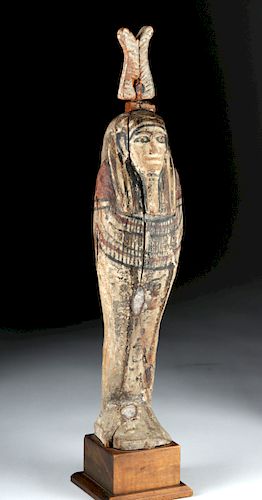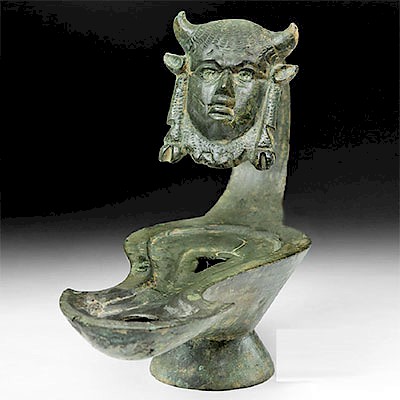Tall Egyptian Painted Wood Ptah Sokar Osiris
Lot 9
About Seller
Artemis Fine Arts
686 S Taylor Ave, Ste 106
Louisville, CO 80027
United States
Selling antiquities, ancient and ethnographic art online since 1993, Artemis Gallery specializes in Classical Antiquities (Egyptian, Greek, Roman, Near Eastern), Asian, Pre-Columbian, African / Tribal / Oceanographic art. Our extensive inventory includes pottery, stone, metal, wood, glass and textil...Read more
Estimate:
$2,000 - $3,000
Absentee vs Live bid
Two ways to bid:
- Leave a max absentee bid and the platform will bid on your behalf up to your maximum bid during the live auction.
- Bid live during the auction and your bids will be submitted real-time to the auctioneer.
Bid Increments
| Price | Bid Increment |
|---|---|
| $0 | $25 |
| $300 | $50 |
| $1,000 | $100 |
| $2,000 | $250 |
| $5,000 | $500 |
| $10,000 | $1,000 |
| $20,000 | $2,500 |
| $50,000 | $5,000 |
| $100,000 | $10,000 |
| $200,000 | $20,000 |
About Auction
By Artemis Fine Arts
Sep 27, 2018
Set Reminder
2018-09-27 10:00:00
2018-09-27 10:00:00
America/New_York
Bidsquare
Bidsquare : Antiquities | Asian | Ethnographic
https://www.bidsquare.com/auctions/artemis-gallery/antiquities-asian-ethnographic-3469
Featuring classical antiquities, ancient and ethnographic art from cultures encompassing the globe. Artemis Fine Arts info@artemisfinearts.com
Featuring classical antiquities, ancient and ethnographic art from cultures encompassing the globe. Artemis Fine Arts info@artemisfinearts.com
- Lot Description
Ancient Egypt, Late Dynastic to Greco-Roman periods, ca. 712 to 30 BCE. An amazing, rare artifact from a culture whose enigmatic funerary rituals hint at a truly lost way of life, this is a painted wooden statuette, originally part of a figural box depicting Ptah-Sokar-Osiris in his human-faced form. This is the Osiris portion of the box, and he is depicted mummiform, with a richly painted wooden surface. A tall crest, representing the ostrich feather Atef crown of Osiris, rises from the top of his head. The god is made of three parts: Ptah, the creator god of Memphis; Sokar, the patron of the Memphite necropolis, and Osiris, the god of the afterlife and lord of the underworld. All three are depicted in mummy forms; Osiris and Ptah as men, and Sokar as a falcon. Together, they tell a story of birth, death, and resurrection. These figures became popular after ca. 1000 BCE and are associated with elite burials. Size: 3.1" W x 15.25" H (7.9 cm x 38.7 cm); 17.4" H (44.2 cm) on included custom stand.
This god would have stood atop a box with a simple hinged lid; a linen-wrapped mummy made of corn would be placed into the hollow box to represent rebirth in the afterlife (the earliest examples instead had funerary papyri placed inside of them). This corn "mummy" was a substitute image of the deceased. This figure represents the complex religious iconography of ancient Egypt and also serves as a good example that this religion and culture was not unchanging over the vast time period that it lasted; instead, new practices and gods arose over time.
Provenance: private Houston, Texas, USA collection
All items legal to buy/sell under U.S. Statute covering cultural patrimony Code 2600, CHAPTER 14, and are guaranteed to be as described or your money back.
A Certificate of Authenticity will accompany all winning bids.
We ship worldwide and handle all shipping in-house for your convenience.
#132927Small loss to platform and lower part of crown. Ancient repair on back of platform and in two places on front - both of these are small (less than .5"). Stable crack up the upper part of the figure (visible on the front). For a wooden item of this age, it is in very nice condition, with well-preserved painted motifs.Condition
- Shipping Info
-
All shipping is handled in-house for your convenience. Your invoice from Artemis Gallery will include shipping calculation instructions. If in doubt, please inquire BEFORE bidding for estimated shipping costs for individual items.
-
- Buyer's Premium



 EUR
EUR CAD
CAD AUD
AUD GBP
GBP MXN
MXN HKD
HKD CNY
CNY MYR
MYR SEK
SEK SGD
SGD CHF
CHF THB
THB















